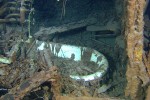 Researchers from RMS Titanic Inc.’s 2010 expedition to the North Atlantic Titanic wreck site presented never before seen images of the ship in a federal court in Norfolk, Virginia on Thursday. The court has already ruled that RMS Titanic is entitled to compensation for the 6000+ artifacts it has recovered from the wreck, but is still working out how the trove should be paid for. The artifacts are estimated to be worth $110 million.
Researchers from RMS Titanic Inc.’s 2010 expedition to the North Atlantic Titanic wreck site presented never before seen images of the ship in a federal court in Norfolk, Virginia on Thursday. The court has already ruled that RMS Titanic is entitled to compensation for the 6000+ artifacts it has recovered from the wreck, but is still working out how the trove should be paid for. The artifacts are estimated to be worth $110 million.
The company released the pictures to the court as evidence of the danger and expense, coupled with the immense scientific and historical value, of their expeditions. Experts from the Woods Hole Oceanographic Institution noted that the pictures are the most high quality ever taken of the wreck.
The most striking images involved the 3-D tour of the Titanic’s stern, which lies 2,000 feet (609 meters) from the bow. Attorneys and court visitors donned 3-D glasses as a camera in a remote-controlled submersible vehicle skimmed over the stern, seemingly transporting viewers through scenes of jagged rusticles sprouting from deck, a length of chain, the captain’s bathtub, and wooden elements that scientists had previously believed had disappeared in the harsh, deep ocean environment.
The images were gathered last year using submersibles that were either tethered to a research vessel or programmed to skim the ocean floor – “mowing the lawn,” in the words of one scientist.
The scientists said previous sonar and optical images were random and akin to snapshots, while the expedition strived to record and map every inch (centimetre) of the wreck and its resting place using the latest recording technologies. Individual images are stitched together in a mosaic process to create large-scale, almost panoramic views of the wreck.
 The expedition also mapped the entire 3-by-5 mile wide wreck site, including the debris field which hasn’t been documented in previous research and salvage operations.
The expedition also mapped the entire 3-by-5 mile wide wreck site, including the debris field which hasn’t been documented in previous research and salvage operations.
The images will now be shared with the public and the scientific community. Such high resolution 3D footage of key parts of the ship — like the jagged edge of the stern where it was torn from the bow — will help experts explain the destruction and sinking of the Titanic and document the increasing deterioration of the wreck.
 Captain Smith’s stateroom, for instance, has declined at an alarming rate. When the wreck was first discovered in 1985, the Captain’s suite was still pretty much intact, with a distinguishable sitting room, bedroom and bathroom, a roof, walls and a floor. Now biodeterioration, the action of microbes breaking down a material, has crumpled the walls, exposing Captain Smith’s lovely bathtub to the cameras exploring the outside of the ship. The roof is also close to collapse.
Captain Smith’s stateroom, for instance, has declined at an alarming rate. When the wreck was first discovered in 1985, the Captain’s suite was still pretty much intact, with a distinguishable sitting room, bedroom and bathroom, a roof, walls and a floor. Now biodeterioration, the action of microbes breaking down a material, has crumpled the walls, exposing Captain Smith’s lovely bathtub to the cameras exploring the outside of the ship. The roof is also close to collapse.
You can view the footage and photographs of the wreck site on Expedition Titanic’s website.